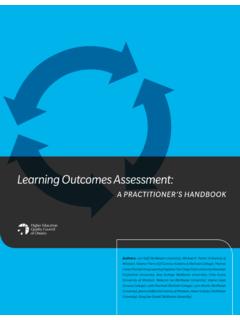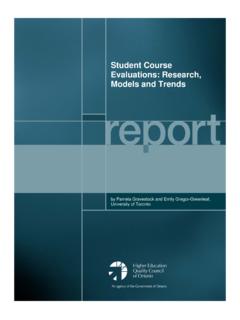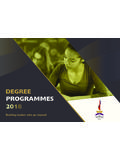Transcription of A Practical Guide for Work-integrated Learning - …
1 A Practical Guide for Work-integrated LearningEffective Practices to Enhance the Educational Quality of Structured work Experiences Offered through Colleges and Universities2 CONTRIBUTING INDIVIDUALSMain WritersAshley Stirling, PhD, University of TorontoGretchen Kerr, PhD, University of TorontoJenessa Banwell, MScEllen MacPherson, MScAmanda Heron, BEdDesignEvelyn Csiszar, Evi Committee MembersMelissa Berger, BACommunity Outreach Coordinator and Manager, UTM Experiential Education OfficeUniversity of Toronto MississaugaTracey Bowen, PhDAssistant Professor Teaching Stream and Internship CoordinatorInstitute of Communications, Culture, Information & TechnologyUniversity of Toronto MississaugaMaria Cantalini-Williams, PhDAssociate Professor, Schulich School of Education, Brantford CampusNipissing UniversityLisa Chambers, MADirector, Centre for Community PartnershipsUniversity of TorontoRuth Childs, PhDAssociate Professor, Department of Leadership, Higher and Adult EducationOntario Institute for Studies in Education (OISE)University of TorontoRick Ezekiel, MScDirector of Research, Innovation and Evaluation (Student Experience)Western UniversityLori Goff, PhDManager, Program EnhancementMcMaster Institute for Innovation & Excellence in Teaching & Learning (MIIETL)
2 McMaster UniversityRobyne Hanley-Dafoe, MEdEducational DeveloperTrent UniversityPamela Healey, MBAD irector, Co-op and Career ServicesConestoga CollegeWilliam R. Holmes, PhDDean, Faculty of ManagementRoyal Roads UniversityDuncan MacDuff, MAResearch FacilitatorNiagara CollegeJohn Marris, PhDDirector, Community-Based ResearchTrent Community Research CentreJane McDonald, PhDProfessor, School of Health and Life Sciences and Community ServicesConestoga CollegeEileen O Connor, PhDAssociate Professor, School of Human KineticsUniversity of OttawaJulie Peters, PhDVP ResearchAcademica Group Preece, PhDProvost and Vice President AcademicSheridan CollegeJudene Pretti, MScDirector, Centre for the Advancement of Co-operative EducationUniversity of WaterlooGeorgia Quartaro, PhDDean.
3 Preparatory and Liberal StudiesGeorge Brown CollegeRod Skinkle, MAPresident & CEOA cademica Group Storer-FoltExperiential Learning Officer, UTM Experiential Education OfficeUniversity of Toronto MississaugaLisa WhalenPresidentEWO (Education at work Ontario)Richard Wiggers, PhDExecutive Director, Research and ProgramsHigher Education Quality Council of Ontario (HEQCO) Queen s Printer for Ontario, 2016A Practical Guide for Work-integrated LearningEffective Practices to Enhance the Educational Quality of Structured work Experiences Offered through Colleges and UniversitiesAn agency of the Government of OntarioAn agency of the Government of OntarioUn organisme du gouvernement de l OntarioUn organisme du gouvernement de l OntarioHIGHER EDUCATION INSTITUTIONS HAVE BECOME INCREASINGLY FOCUSED ON THE QUALITY OF TEACHING AND Learning , AND THE PROVISION OF HIGH-QUALITY EDUCATIONAL EXPERIENCES FOR STUDENTS IN VARIOUS Learning CONTEXTS.
4 WELL-DESIGNED Work-integrated Learning IS OF BENEFIT TO THE STUDENT, THE ACADEMIC INSTITUTION, THE HOST INSTITUTION/EMPLOYER AND THE Work-integrated Learning , STUDENTS BRING NEW IDEAS AND INNOVATION TO INDUSTRY, GOVERNMENT AND COMMUNITY AND UNIVERSITIES ARE RECOGNIZING THE EDUCATIONAL IMPACT OF Work-integrated Learning , AND IT IS BECOMING INCREASINGLY POPULAR IN HIGHER EDUCATION FOR Work-integrated Learning SPAN THE BREADTH OF DISCIPLINARY AREAS, FROM THE SOCIAL SCIENCES AND HUMANITIES TO ENVIRONMENTAL, PHYSICAL, HEALTH AND APPLIED SCIENCES, FINE ARTS, BUSINESS AND VOCATIONAL DONE CORRECTLY, OPPORTUNITIES FOR STUDENTS TO LEARN OUTSIDE THE CLASSROOM IN A work ENVIRONMENT AUGMENT STUDENTS ACADEMIC Learning AND DEVELOP work -READY PARTNERSHIPS BETWEEN THE ACADEMIC INSTITUTION AND THE WORKPLACE ENHANCE THE INTEGRATION OF THEORY AND PRACTICE WITHIN AND BETWEEN ACADEMIC AND WORKPLACE ENVIRONMENTS.
5 3 Work-integrated Learning OPPORTUNITIES FOSTER PERSONAL AND PROFESSIONAL GROWTH AND ENRICH STUDENTS HIGHER EDUCATION EXPERIENCE. 4 THIS Guide IS INTENDED TO SERVE AS A RESOURCE TO ENHANCE STUDENT Learning AND DEVELOPMENT IN HIGHER EDUCATION THROUGH THE STRUCTURED work EXPERIENCE Work-integrated Learning is a pedagogical practice whereby students come to learn from the integration of experiences in educational and workplace settings (Billett, 2009). work - integrated Learning has emerged as a key pedagogical strategy to enhance student Learning and development (Kennedy, Billett, Gherardi & Grealish, 2015). Int egrating curricular Learning with workplace experience provides students with an opportunity to combine theory and practice in a real-world work environment, deepening students knowledge and understanding, and enhancing work -related capabilities (Cooper, Orrell & Bowden, 2010).
6 Work-integrated Learning is becoming increasingly popular in higher education (Smigiel, Macleod & Stephenson, 2015). Almost half of the postsecondary students in Ontario direct-entry programmes will experience Work-integrated Learning by graduation (Sattler & Peters, 2013). This does not take into account the vast number of Work-integrated Learning opportunities offered by second-entry/graduate TypologyThe term Work-integrated Learning (WIL) is often used interchangeably with work -based Learning , practice-based Learning , work -related Learning , vocational Learning , experiential Learning , co-operative education, clinical education, internship, practicum and field education, to name but a few (Sattler, 2011).
7 In an attempt to provide clarity around Work-integrated Learning terminology, several models and typologies of Work-integrated Learning have been proposed (Calway, 2006; Cooper et al., 2010; Furco, 2006; Guile & Griffiths, 2001; Keating, 2006; Rowe, Mackaway & Winchester-Seeto, 2012; Schuetze & Sweet, 2003). Specifically describing the provision of Work-integrated Learning in Ontario s postsecondary sector, Sattler (2011, p. 29) outlines a typology to explain the different types of Work-integrated Learning experiences in colleges and universities, including: systematic training, in which the workplace is the central piece of the Learning ( , apprenticeships); the structured work experience, in which students are familiarized with the world of work within a postsecondary education programme ( , field experience, professional practice, co-op, internships); and institutional partnerships, which refer to postsecondary education activities [designed] to achieve industry or community goals ( , service Learning ).
8 Work-integrated LEARNINGS ystematic TrainingWorkplace as the central piece of Learning ( , apprenticeships)Structured work ExperienceFamiliarization with the world of work within a postsecondary education programme ( , field experience, professional practice, co-op, internships)Institutional PartnershipsPostsecondary education activities to achieve industry or community goals ( , service Learning )(Sattler, 2011)6 Key Dimensions of WILIn addition to models and typologies, key dimensions of Work-integrated Learning programming have been suggested. Cooper, Orwell and Bowden (2010) identify seven key dimensions, including: purpose, context, the nature of the integration, curriculum issues, Learning , institutional partnerships, and the support provided to the student and the workplace.
9 Building upon this list, Cantalini-Williams (2015) proposed her CANWILL framework for developing effective Work-integrated Learning practicums (curriculum, assessment, networking, workplace, integration, Learning and logistics), adding assessment and logistics as dimensions to the delivery of Work-integrated Learning OF Work-integrated LEARNINGC urriculumPurposeAssessmentContextNetwork ingNatureWorkplaceCurriculumIntegrationL earningLearningInstitutional PartnershipsLogisticsSupport7 THIS Guide IS INTENDED TO SERVE AS A RESOURCE TO ENHANCE STUDENT Learning AND DEVELOPMENT IN HIGHER EDUCATION THROUGH THE STRUCTURED work Focus of this GuideThis Guide is intended to serve as a resource for faculty, staff, academic leaders and educational developers engaged in Work-integrated Learning programme development, facilitation and/or evaluation.
10 The focus of this Guide is on enhancing the educational quality of Work-integrated Learning programmes. Several aspects of Cooper et al. s (2010) and Cantalini-Williams (2015) dimensions of work - integrated Learning , such as purpose, context and institutional partnerships, will be referenced throughout the Guide , with student Learning as the main dimension of focus. Using Kolb s experiential Learning cycle, we suggest effective practices to address each of the Learning modes of experience, reflection, theorization and experimentation within a higher education Work-integrated Learning programme, in order to optimize student Learning and development. While the information included in this Guide may apply to several types of Work-integrated Learning , including systematic training ( , apprenticeship) and institutional partner-ships ( , service Learning ), this Guide was developed with a focus on the structured Work-integrated Learning experience, such as internships, placements, co-ops, field experiences, professional practice and clinical practicums.







